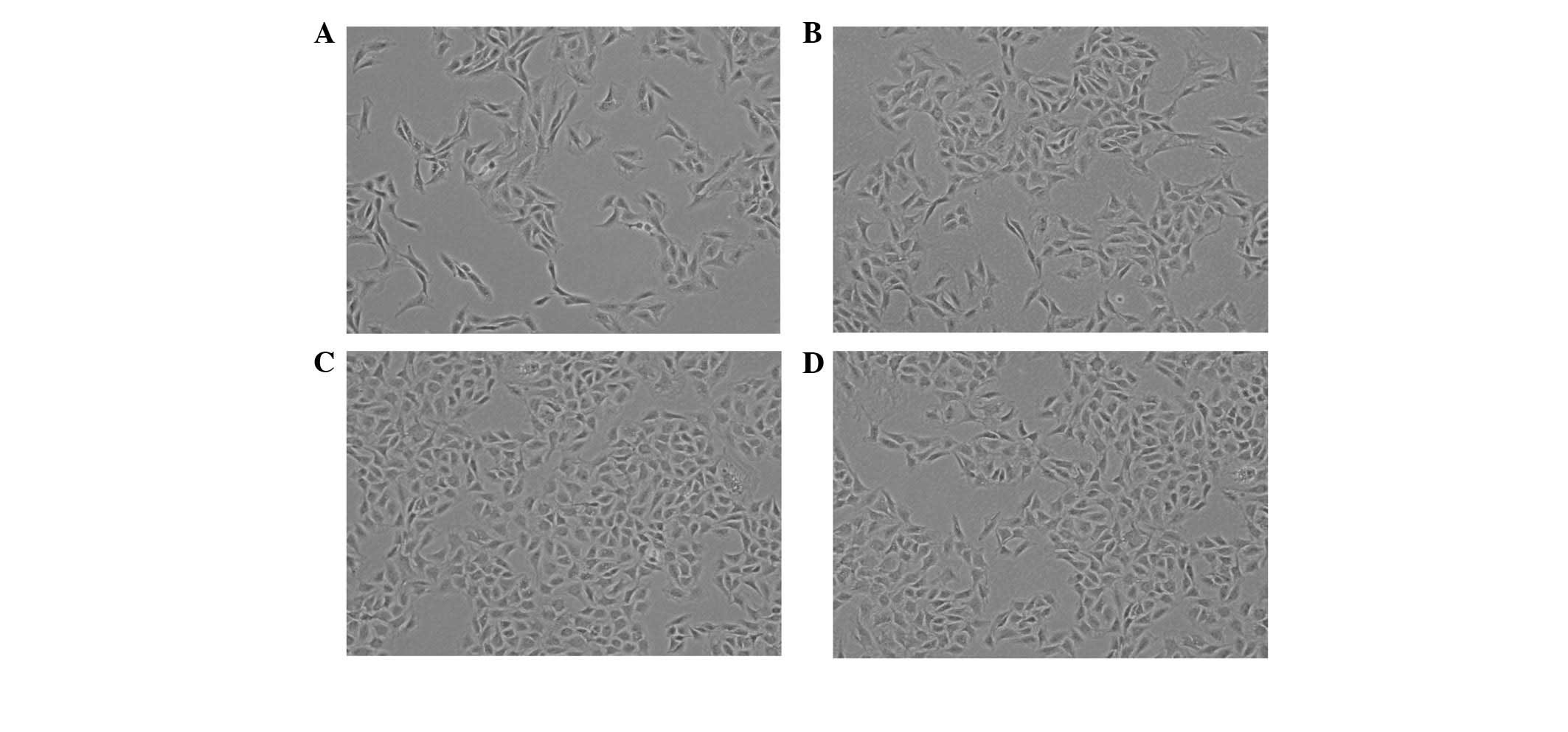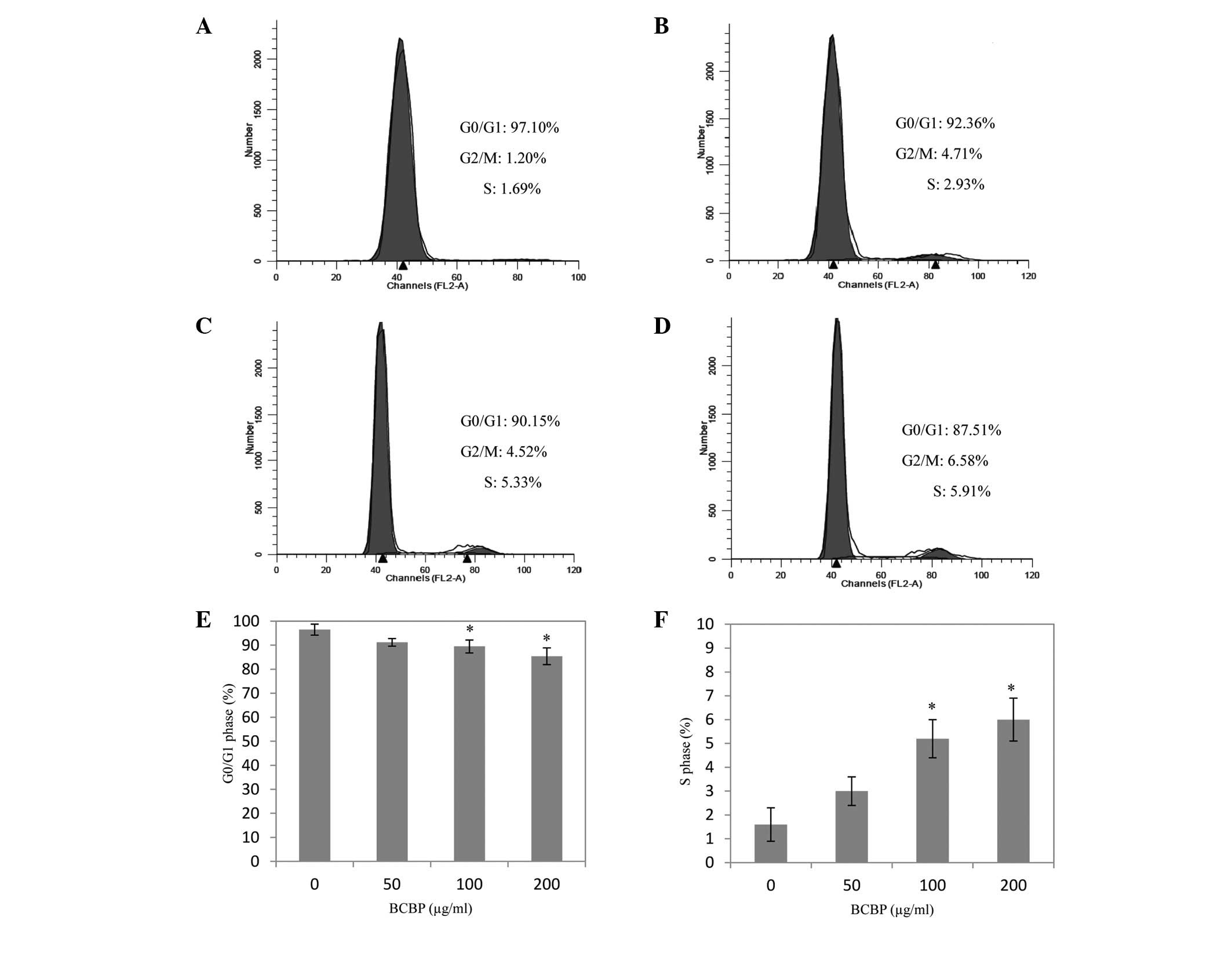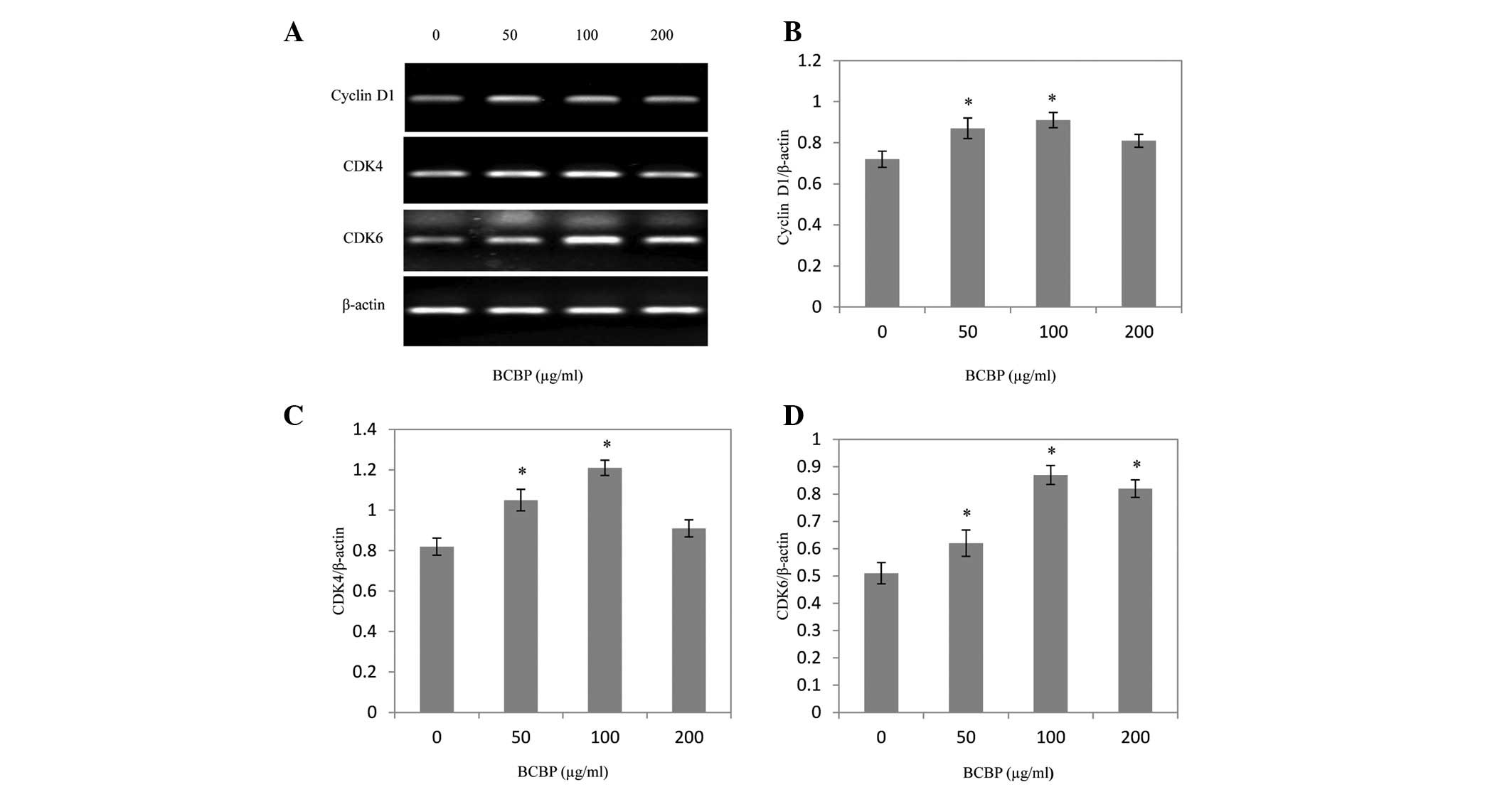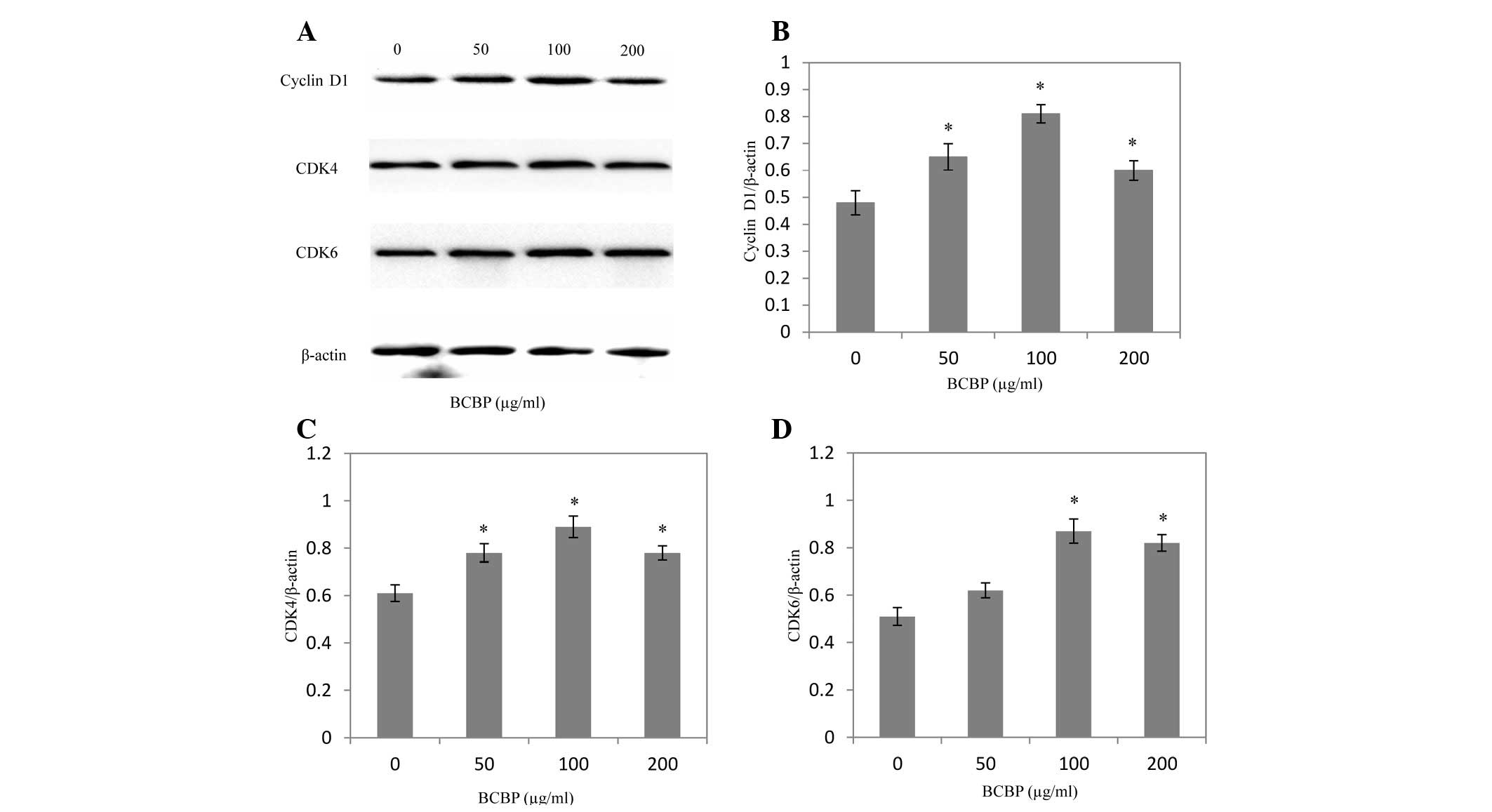Effects of Bauhinia championii (Benth.) Benth. polysaccharides on the proliferation and cell cycle of chondrocytes
- Authors:
- Published online on: March 13, 2013 https://doi.org/10.3892/mmr.2013.1368
- Pages: 1624-1630
Abstract
Introduction
Osteoarthritis (OA) is a joint disease, characterized by the degeneration of articular cartilage and bone remodeling that clinically results in pain and joint stiffness, which involves mechanical and biological factors (1,2). Adult articular cartilage consists of a relatively sparse population of non-proliferating chondrocytes which produce a large amount of extracellular matrix (ECM), mainly composed of two major types of macromolecules, collagens (types II, IX and XI) and proteoglycans. Chondrocytes are responsible for tissue homeostasis, including the synthesis and degradation of ECM components (3). Therefore, chondrocyte proliferation is important in maintaining cellular function.
The cell cycle represents a highly regulated series of events that leads to eukaryotic cell reproduction. During the early stages of the cell cycle, DNA is replicated and the chromosomes are duplicated during the transition through to the S phase. This process begins at specific DNA sites known as replication origins. At these sites, the DNA replication licensing machinery opens the DNA double helix, exposing it to enzymes that conduct DNA synthesis (4). The S phase is followed by chromosomal segregation and nuclear and cell division, which is collectively termed the M phase. The majority of cell cycles contain additional gap phases between the G1 and S phase, which provide more time for growth and also serve as important regulatory transitions, during which progression to the next cell cycle stage is controlled by intracellular and extracellular signals (5,6). G1 is a particularly important regulatory period, since it is during this phase that most cells either become committed to continued division or exit from the cell cycle (7,8).
The destiny of a cell is strictly controlled by a set of cell cycle factors. In particular, the Ser/Thr protein kinases CDK4 and CDK6 are important for cell cycle progression at the G1 phase. Cyclin D1 is also a positive regulator of the G1/S transition and functions as one of the key restriction points in the cell cycle by binding to CDK4 or CDK6 to control cell cycle progression from the G1 to the S phase (9).
Bauhinia championii (Benth.)
Benth. polysaccharide (BCBP) treatment promotes chondrocyte proliferation and may be associated with the upregulation of cyclin D1, CDK4 and CDK6 levels, which are important targets in the G1/S transition of the cell cycle.
Natural products have been considered as alternative medicine for several years. Numerous plants and their constituents have been shown to possess beneficial therapeutic effects for various diseases (10). Polysaccharides isolated from plants have attracted a large amount of research attention due to their broad spectrum of therapeutic properties and their relatively low toxicity (11–13). In modern pharmacological studies, polysaccharides isolated from plants have been shown to carry out anti-inflammatory, anti-oxidant and antitumor activities (14–16). However, to the best of our knowledge, no previous studies have been conducted on the effects of BCBP on chondrocytes.
In the present study, polysaccharides from Bauhinia championii (Benth.) Benth. were obtained using water extraction and ethanol precipitation. To investigate the effects of BCBP on the proliferation and cell cycle of chondrocytes, an MTT assay was used to evaluate the proliferative activity of BCBP. In addition, the cell cycle distribution was detected by flow cytometry. Furthermore, the mRNA and protein expression levels of cyclin D1, CDK4 and CDK6 were determined using reverse transcription polymerase chain reaction (RT-PCR) and western blot analysis, respectively.
Materials and methods
Drug preparation. Bauhinia championii (Benth.)
Benth. was ground and dried and the powder (100 g) was extracted with pure water (1:15, w/v) at 85°C for 6 h, followed by centrifugation at 3,000 r/min for 15 min. Water extracts were collected and the dregs extracted. The combined extracts were pooled and condensed to ~100 ml under a reduced pressure. Subsequently, 400 ml of 95% alcohol by volume was slowly added by stirring to precipitate the polysaccharides. This polysaccharide sediment was further refined by repeated dissolution and precipitation 3 times, followed by a wash with ethanol, acetone and ether (17).
Animals
Healthy and clean 4-week-old male Sprague-Dawley rats (n=30; weight, 90–110 g) were purchased from the Shanghai Laboratory Animal Commission (SLAC, Shanghai, China). The animal license number for the rats was SCXK (Shanghai) 2008–0005. Experiments involving the animals complied with the Guidance Suggestions for the Care and Use of Laboratory Animals 2006 administered by the Ministry of Science and Technology of the People’s Republic of China (18).
Reagents
Fetal bovine serum (FBS), Dulbecco’s modified Eagle’s medium (DMEM) and Trypsin-EDTA were obtained from HyClone (Logan, UT, USA). Type II collagenase and 3-(4,5-dimethythiazol-2-yl)-2,5-diphenyltetrazolium bromide (MTT) were obtained from Sigma-Aldrich (St. Louis, MO, USA). The TRIzol reagent was obtained from Invitrogen (Carlsbad, CA, USA). A reverse transcription test kit was obtained from Promega (Madison, WI, USA) and the cell cycle test kit was purchased from Becton-Dickinson (San Jose, CA, USA). A total protein extraction kit was purchased from Nanjing KeyGen Biotech Co., Ltd. (Nanjing, China). Polyvinylidene fluoride (PVDF) membranes were purchased from Millipore (Billerica, MA, USA). Rabbit anti-cyclin D1, -CDK4, -CDK6 and -β-actin and HRP secondary goat anti-rabbit antibodies were purchased from Santa Cruz Biotechnology, Inc. (Santa Cruz, CA, USA). Any additional chemicals, unless otherwise stated, were obtained from Sigma-Aldrich.
Isolation and culture of rat chondrocytes
Articular cartilage obtained from rat knee joints was rinsed in PBS and DMEM three times. The cartilage was sectioned into 1-mm3 slices, digested with 0.2% type II collagenase and then transferred to a 37°C incubator to isolate the chondrocytes. The supernatant was collected every 2 h and centrifuged at 1,000 r/min for 5 min to obtain the cell pellet. The cells were then filtered through 200 mesh stainless steel filters, seeded (5×105 cells/ml) in 6-well plates in DMEM containing 10% FBS and cultivated in a CO2 incubator (5% CO2 at 37°C) (19). The primary cultured cells were observed under an inverted microscope and passaged upon reaching 80% confluence.
Identification of chondrocytes using immunohistochemical staining
The second generation chondrocytes were seeded onto cover slips and cultured for 72 h. The cells were washed with PBS and fixed in 4% neutral formalin for 30 min. Subsequent steps were performed according to the manufacturer’s instructions. The expression of type II collagen was observed using immunohistochemical staining. Images were captured at a magnification of ×40.
Evaluation of cell viability using the MTT assay
The viability of chondrocytes was assessed using the MTT colorimetric assay. The second passage chondrocytes were seeded in 96-well plates at a density of 1.0×104 cells/well in 0.1 ml of 10% FBS/DMEM. The chondrocytes were treated with various concentrations of BCBP for 24, 48 or 72 h. The medium was then removed and 20 μl of 0.5% MTT solution was added to each well, followed by incubation at 37°C for 4 h. The purple-blue MTT formazan precipitate was dissolved in 100 μl dimethyl sulfoxide (DMSO). The absorbance was measured at 490 nm using an ELISA reader (ELx800™; BioTek Instruments, Inc., Winooski, VT, USA).
Cell cycle analysis using flow cytometry with PI staining
Chondrocytes were seeded in 35-mm petri dishes at a density of 5×104 cells/ml. The chondrocytes were treated with various concentrations of BCBP for 48 h. The cells were then digested, collected and resuspended in PBS. The cell concentration was adjusted to 1×106 cells/ml following centrifugation. Solutions A, B and C were added according to the manufacturer’s instructions. ModFit software was used to analyze the DNA content and to count the cell numbers in the G0/G1, S and G2/M phases.
RNA extraction and RT-PCR analysis
Chondrocytes (1×105) were seeded in 6-well plates in 2 ml of medium and treated with various concentrations of BCBP for 48 h. Total RNA was isolated with TRIzol reagent. RNA (1 μg) was reverse transcribed into cDNA. The obtained cDNA was used to determine the mRNA levels of cyclin D1, CDK4 and CDK6. β-actin was used as an internal control. The sequences of the primers used for amplification of cyclin D1, CDK4 and CDK6 were as follows: Cyclin D1 forward, 5′-AAT GCC AGA GGC GGA TGA GA-3′ and reverse, 5′-GCT TGT GCG GTA GCA GGA GA-3′, 189 bp; CDK4 forward, 5′-GAA GAC GAC TGG CCT CGA GA-3′ and reverse, 5′-ACT GCG CTC CAG ATT CCT CC-3′, 109 bp; CDK6 forward, 5′-TTG TGA CAG ACA TCG ACG AG-3′ and reverse, 5′-GAC AGG TGA GAA TGC AGG TT-3′, 151 bp; and β-actin forward, 5′-CGT TGA CAT CCG TAA AGA CC-3′ and reverse, 5′-GGA GCC AGG GCA GTA ATC T-3′, 108 bp.
Western blot analysis
Chondrocytes were seeded in culture flasks and treated with or without BCBP at 37°C for 48 h. Cells were scraped from the culture, washed twice with PBS and then suspended in 30 μl western blotting lysis buffer. The protein concentration was determined using a bicinchoninic acid (BCA) protein assay. Samples were loaded with 20 μg protein and separated by electrophoresis on 12% SDS-polyacrylamide gels. Following electrophoresis, protein blots were transferred to PVDF membranes. The membranes were blocked with 5% skimmed milk in TBST solution and incubated overnight with the primary antibodies at 4°C. The membranes were then washed in TBST and exposed to secondary antibodies. The membranes were developed by ECL Plus Western Blotting Detection Reagents (Molecular Imager ChemiDoc XRS System; Bio-Rad, Hercules, CA, USA)
Statistical analysis
Data were presented as the mean ± standard deviation (SD) when appropriate. All the experiments were repeated at least three times and the representative results are shown. Results were analyzed by one-way ANOVA (control vs. treatments) followed by Student’s t-test using SPSS 16.0 software. P<0.05 was considered to indicate a statistically significant difference.
Results
Morphological observation and characterization of chondrocytes
The second generation chondrocytes were treated with various concentrations of BCBP for 48 h. BCBP treatment significantly increased the total number of chondrocytes compared with the untreated control cells (Fig. 1), indicating that BCBP promotes chondrocyte proliferation.
To characterize the chondrocytes, the effects of BCBP on type II collagen expression were evaluated using immunohistochemical staining. Type II collagen matrix is a chondrocyte-specific protein and may be used as a biomarker to identify chondrocytes (20,21). The results demonstrated that the cytoplasm of the negative group of cells was unstained (Fig. 2A), whereas the cytoplasm of chondrocytes was stained a brown-yellow color (Fig. 2B).
Effect of BCBP on the viability of chondrocytes
The cells were treated with 50–200 μg/ml BCBP for 48 h to evaluate the effect of BCBP on the viability of chondrocytes. As shown in Fig. 3, the viability of chondrocytes was increased by 18.72±2.61, 30.13±3.24 and 26.87±3.77% when the cells were treated with 50, 100 and 200 μg/ml of BCBP, respectively. Furthermore, the viability of chondrocytes was increased by 3.24±2.06, 11.57±2.30 and 19.73±2.42% when the cells were treated with 200 μg/ml BCBP for 24, 48 and 72 h, respectively, compared with untreated cells (P<0.05).
Effect of BCBP on the cell cycle of chondrocytes
Chondrocytes were treated with 50, 100 and 200 μg/ml of BCBP for 48 h to explore the effect of BCBP on cell cycle progression. As shown in Fig. 4, BCBP treatment decreased the percentage of cells in the G0/G1 phase, while the percentage of cells in the S phase was increased (P<0.05). Taken together, the results suggest that BCBP enhances cell cycle progression of the chondrocytes by promoting the G1 to S phase transition.
Effect of BCBP on the expression of cyclin D1, CDK4 and CDK6 in chondrocytes
Following BCBP treatment for 48 h, the mRNA and protein expression levels of cyclin D1, CDK4 and CDK6 were determined using RT-PCR and western blot analysis, respectively. The results of the RT-PCR assay showed that BCBP treatment significantly increased cyclin D1, CDK4 and CDK6 mRNA expression levels in chondrocytes (P<0.05, Fig. 5). The protein expression patterns of cyclin D1, CDK4 and CDK6 were similar to those of their respective mRNA levels (P<0.05, Fig. 6).
Discussion
OA, the most common age-related cartilage and joint disorder, is a slow progressing degenerative disease characterized by the degradation of the ECM and cell death resulting in a gradual loss of articular cartilage integrity (22–24). The only cell type present in mature cartilage is chondrocytes, which are responsible for repairing damaged cartilage tissue.
Low proliferative activity in osteoarthritic chondrocytes has recently been demonstrated; therefore, a treatment that promotes the proliferative activity of chondrocytes may be efficient to delay or even cease the progression of OA (25). The present study mainly focused on exploring drugs that promote the proliferation of chondrocytes.
Bauhinia championii (Benth.)
Benth. is a herbal medicine demonstrated to be clinically effective in treating OA. It possesses the functions of expelling wind and removing dampness, in addition to promoting blood circulation and relieving pain. However, the mode of action of this treatment for OA remains to be elucidated. Before Bauhinia championii (Benth.) Benth. is further developed as an agent for treating OA, its underlying molecular mechanism requires investigation.
The cell cycle is composed of four different stages; the G1, S, G2 and M phases. Preparation for DNA synthesis occurs during the G1 phase, DNA synthesis is carried out during the S phase, preparation for mitosis occurs in the G2 phase and mitosis is achieved in the M phase. The amount of DNA in a cell changes during the cell cycle, allowing the different stages of the cycle to be identified by analyzing the DNA content. The DNA content is 2N in the G0 and G1 phases. Following DNA synthesis in the S phase, DNA content becomes 4N in the G2 and M phases (26,27). Flow cytometric analysis, which measures the DNA content of cells, is more sensitive to the changes during the cell cycle compared with the MTT method. In the present study, cell cycle distribution was carried out using flow cytometry. The results showed that after BCBP treatment, the G0/G1 ratio was reduced and the S ratio increased, indicating that BCBP treatment promotes cell proliferation by enhancing G1 phase entry and accelerating the G1/S transition.
G1/S and G2/M are two important checkpoints regulating stage transition and cell cycle progression. Stage transitions in the cell cycle are controlled by interactions among the molecules of the cyclin-CDK-CDK inhibitor (CKI) axis. In this system, cyclins interact with CDKs to positively regulate their activity (28,29). Cyclin D1, CDK4 and CDK6 are important in the G1/S transition of the cell cycle. The mRNA and protein expression levels of cyclin D1, CDK4 and CDK6 in chondrocytes were detected using RT-PCR and western blot analysis, respectively. The results showed that BCBP treatment effectively enhanced the mRNA and protein levels of cyclin D1, CDK4 and CDK6. In agreement with these results, flow cytometric analysis showed that the S ratio increased, while the G1 ratio decreased with BCBP treatment.
In conclusion, the present study has demonstrated that BCBP promotes chondrocyte proliferation by accelerating the G1/S transition and upregulating the expression of cyclin D1, CDK4 and CDK6. These results suggest that BCBP is a potential novel therapeutic agent for the treatment of knee OA.
Acknowledgements
This study was supported by the National Natural Science Foundation of China (no. 81072826), the Natural Science Foundation of Fujian Province (no. 2010Y0032) and the Chen Keji Integrative Medicine Developmental Foundation (no. CKJ2011003).
Abbreviations:
|
BCBP |
Bauhinia championii (Benth.) Benth. polysaccharide |
|
OA |
osteoarthritis |
|
DMSO |
dimethyl sulfoxide |
|
MTT |
3-(4,5-dimethythiazol-2-yl)-2,5-diphenyltetrazolium bromide |
References
|
Wattanachai T, Yonemitsu I, Kaneko S and Soma K: Functional lateral shift of the mandible effects on the expression of ECM in rat temporomandibular cartilage. Angle Orthod. 79:652–659. 2009. View Article : Google Scholar : PubMed/NCBI | |
|
Gentili C and Cancedda R: Cartilage and bone extracellular matrix. Curr Pharm Des. 15:1334–1348. 2009. View Article : Google Scholar : PubMed/NCBI | |
|
Brondello JM, Philipot D, Djouad F, Jorgensen C and Noël D: Cellular Senescence is a Common Characteristic Shared by Preneoplasic and Osteo-Arthritic Tissue. Open Rheumatol J. 4:10–14. 2010. View Article : Google Scholar : PubMed/NCBI | |
|
Grimmer C, Balbus N, Lang U, Aigner T, Cramer T, Müller L, Swoboda B and Pfander D: Regulation of type II collagen synthesis during osteoarthritis by proly-4-hydroxylases: possible influence of low oxygen levels. Am J Pathol. 169:491–502. 2006. View Article : Google Scholar : PubMed/NCBI | |
|
Tsuji K, Bandyopadhyay A, Harfe BD, Cox K, Kakar S, Gerstenfeld L, Einhorn T, Tabin CJ and Rosen V: BMP2 activity, although dispensable for bone formation, is required for the initiation of fracture healing. Nat Genet. 38:1424–1429. 2006. View Article : Google Scholar : PubMed/NCBI | |
|
Sherr CJ and Roberts JM: Living with or without cyclins and cyclin-dependent kinases. Genes Dev. 18:2699–2711. 2004. View Article : Google Scholar : PubMed/NCBI | |
|
Planas-Silva MD and Weinberg RA: The restriction point and control of cell proliferation. Curr Opin Cell Biol. 9:768–772. 1997. View Article : Google Scholar : PubMed/NCBI | |
|
Zetterberg A and Larsson O: Kinetic analysis of regulatory events in G1 leading to proliferation or quiescence of Swiss 3T3 cells. Proc Natl Acad Sci USA. 82:5365–5369. 1985. View Article : Google Scholar : PubMed/NCBI | |
|
Zhang M, Xie R, Hou W, Wang B, Shen R, Wang X, Wang Q, Zhu T, Jonason JH and Chen D: PTHrP prevents chondrocyte premature hypertrophy by inducing cyclin-D1-dependent Runx2 and Runx3 phosphorylation, ubiquitylation and proteasomal degradation. J Cell Sci. 122:1382–1389. 2009. View Article : Google Scholar : PubMed/NCBI | |
|
Newman DJ, Cragg GM and Snader KM: The influence of natural products upon drug discovery. Nat Prod Rep. 17:215–234. 2000. View Article : Google Scholar : PubMed/NCBI | |
|
Tzianabos AO: Polysaccharide immunomodulators as therapeutic agents: structural aspects and biological function. Clin Microbiol Rev. 13:523–533. 2000. View Article : Google Scholar : PubMed/NCBI | |
|
Paulsen BS: Plant polysaccharides with immunostimulatory activities. Curr Org Chem. 5:939–950. 2001. View Article : Google Scholar | |
|
Wasser SP: Medicinal mushrooms as a source of antitumor and immunomodulating polysaccharides. Appl Microbiol Biotechnol. 60:258–274. 2002.PubMed/NCBI | |
|
Xu R, Ye H, Sun Y, Tu Y and Zeng X: Preparation, preliminary characterization, antioxidant, hepatoprotective and antitumor activities of polysaccharides from the flower of tea plant (Camellia sinensis). Food Chem Toxicol. 50:2473–2480. 2012. View Article : Google Scholar | |
|
Zhang BZ, Yan PS, Chen H and He J: Optimization of production conditions for mushroom polysaccharides with high yield and antitumor activity. Carbohydr Polym. 87:2569–2575. 2012. View Article : Google Scholar | |
|
Hua Y, Gao Q, Wen L, Yang B, Tang J, You L and Zhao M: Structural characterisation of acid- and alkali-soluble polysaccharides in the fruiting body of Dictyophora indusiata and their immunomodulatory activities. Food Chem. 132:739–743. 2012. View Article : Google Scholar | |
|
Sui Z, Gizaw Y and BeMiller JN: Extraction of polysaccharides from a species of Chlorella. Carbohydr Polym. 90:1–7. 2012. View Article : Google Scholar : PubMed/NCBI | |
|
The Ministry of Science and Technology of the People’s Republic of China. Guidance Suggestions for the Care and Use of Laboratory Animals. Beijing, China: 2006 | |
|
Li X, Du M, Liu X, et al: Millimeter wave treatment promotes chondrocyte proliferation by upregulating the expression of cyclin-dependent kinase 2 and cyclin A. Int J Mol Med. 26:77–84. 2010.PubMed/NCBI | |
|
Machida YJ, Hamlin JL and Dutta A: Right place, right time, and only once: replication initiation in metazoans. Cell. 123:13–24. 2005. View Article : Google Scholar : PubMed/NCBI | |
|
Nigg EA: Mitotic kinases as regulators of cell division and its checkpoints. Nat Rev Mol Cell Biol. 2:21–32. 2001. View Article : Google Scholar : PubMed/NCBI | |
|
Heinegård D, Bayliss MT and Lorenzo P: Biochemistry and metabolism of normal and osteoarthritic cartilage. Osteoarthritis. Brandt KD, Doherty M and Lohmander LS: Oxford University Press; New York, NY: pp. 74–84. 1998 | |
|
Pritzker KPH: Pathology of osteoarthritis. Osteoarthritis. Brandt KD, Doherty M and Lohmander LS: Oxford University Press; New York, NY: pp. 50–61. 1998 | |
|
Kim HA and Blanco FJ: Cell death and apoptosis in osteoarthritic cartilage. Curr Drug Targets. 8:333–345. 2007. View Article : Google Scholar : PubMed/NCBI | |
|
Chan BY, Fuller ES, Russell AK, et al: Increased chondrocyte sclerostin may protect against cartilage degradation in osteoarthritis. Osteoarthritis Cartilage. 19:874–885. 2011. View Article : Google Scholar : PubMed/NCBI | |
|
Hwang SG, Song SM, Kim JR, Park CS, Song WK and Chun JS: Regulation of type II collagen expression by cyclin-dependent kinase 6, cyclin D1, and p21 in articular chondrocytes. IUBMB Life. 59:90–98. 2007. View Article : Google Scholar : PubMed/NCBI | |
|
Li TF, Chen D, Wu Q, et al: Transforming growth factor-β stimulates cyclin D1 expression through activation of β-catenin signaling in chondrocytes. J Biol Chem. 281:21296–21304. 2006. | |
|
Susaki E, Nakayama K, Yamasaki L and Nakayama KI: Common and specific roles of the related CDK inhibitors p27 and p57 revealed by a knock-in mouse model. Proc Natl Acad Sci USA. 106:5192–5197. 2009. View Article : Google Scholar : PubMed/NCBI | |
|
Cheng A and Solomon MJ: Speedy/Ringo C regulates S and G2 phase progression in human cells. Cell Cycle. 7:3037–3047. 2008. View Article : Google Scholar : PubMed/NCBI |















